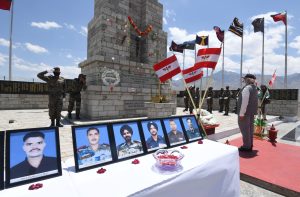Almost four-and-half years after Indian and Chinese troops clashed violently at Galwan Valley in Ladakh, resulting in the first fatal confrontation between the two countries along their disputed border since 1975, the India-China standoff in the Himalayas appears to be reaching an end.
“Agreement has been arrived at on patrolling arrangements along the Line of Actual Control (LAC) in the India-China border areas, leading to disengagement and a resolution of the issues that had arisen in these areas in 2020,” India’s Foreign Secretary Vikram Misri told journalists in New Delhi on Monday. Misri was briefing the media on Prime Minister Narendra Modi’s upcoming visit to Kazan, Russia for the BRICS summit on October 22 and 23.
The timing of the announcement is significant.
It came just a day before the Indian prime minister leaves for Russia to attend the BRICS meeting, which will be attended by Chinese President Xi Jinping, among others.
Misri didn’t confirm if a meeting between Modi and Xi on the sidelines of the BRICS summit was in the cards. But he didn’t rule out the possibility of such a meeting either. Although the BRICS summit is “a multilateral event,” he said, “there is always a provision for bilateral meetings on the sidelines.” There have been “a number of requests for bilateral meetings,” he said, without elaborating if a meeting with Xi figured among these.
In the context of the agreement, which appears to be a major breakthrough, it is likely that we will see a Modi-Xi handshake, perhaps even a meeting, on the sidelines of the BRICS summit.
India-China relations have been frosty in recent years. In April-May 2020, soldiers of China’s People’s Liberation Army intruded in large numbers into areas that were traditionally claimed and patrolled by the Indian Army. Then on the night of June 14-15, bloody clashes erupted between Indian and Chinese soldiers at Galwan Valley. That face-off triggered a rapid deterioration in bilateral relations. Tensions along the entire LAC, their de facto border, spiraled, and the two sides quickly stepped up deployment to around 50,000 to 60,000 troops each and built up their military infrastructure along the border.
So frosty were bilateral relations that Modi and Xi, who had met around 18 times prior to the 2020 Galwan clashes, spoke to each other only twice, and only very briefly, in the years thereafter: on the sidelines of the G-20 summit in Indonesia in 2022 and at the BRICS summit in South Africa in 2023.
In fact, Xi didn’t attend the G-20 summit India hosted in New Delhi last year.
Since the Galwan clashes, there have been multiple rounds of meetings between representatives of the Indian and Chinese diplomatic and security establishments as well as their military commanders. Both sides have revealed little of what transpired at these meetings but it did seem that things were not going in India’s favor in the talks.
Not only had Chinese troops prevented Indian soldiers “from patrolling areas of the LAC that both sides claimed and patrolled by mutual consent” – Manoj Joshi, author of “Understanding the India-China Border: The Enduring Threat of War in the High Himalayas” told The Diplomat in an interview in October 2022 that “The Chinese action in April-May 2020,” which “was in the form of blockades” could have resulted in India losing “anywhere up to 2,000 square kilometers of territory if you count the Depsang Bulge, the Kugrang river Valley, Galwan, Pangong, and the Charding Nala areas”—but also, India was losing territory to the Chinese at the talks table as it had agreed to the creation of ‘no patrolling buffer zones’ at ‘friction points’ which were “largely” “in what India claims to be its territory.”
Importantly, while India and China did reach some kind of a resolution, albeit a flawed one based on questionable “buffer zones”at “friction points” at Galwan Valley, the north and south banks of Pangong Tso, and Gogra-Hot Springs, the Chinese were unwilling to even discuss “friction points” at Depsang Plains and Demchok, which they insisted were “legacy issues” i.e. they go back to 2013 and do not pertain to the April-May 2020 situation in Ladakh, a retired senior officer of the Indian Army’s Northern Command told The Diplomat.
On Monday, Misri said that the sides had reached an agreement on “the issues that had arisen in these areas in 2020.” However, he revealed little about the details of the agreement. There was no clarity on the nature of the patrolling arrangements. Besides, he provided no details on “whether there would be a reversion to the status quo pre-2020, and whether the ‘buffer zones’ more recently created would continue to exist for patrolling purposes.”
Importantly, he did not reveal whether it covered all friction points, including Depsang Plains and Demchok.
Hours after Misri’s announcement, India’s Minister for External Affairs S. Jaishankar said: “What [the] Foreign Secretary has said is what I can also say, that we reached an agreement on patrolling and with that we have gone back to where the situation was in 2020. We can say that the disengagement process with China has been completed.”
“We will be able to do the patrolling which we were doing in 2020,” Jaishankar added.
According to the retired Indian Army officer, “the agreement that was announced today appears to include Depsang Plains and Demchok.” If this is indeed true, this is a “major achievement.”
“If China is accommodating on Depsang and Demchok, a resolution of the Sino-India territorial dispute in eastern Ladakh would be a possibility,” defense analyst Ajai Shukla wrote in Business Standard.
All eyes will now turn to Kazan. Will the frosty India-China relations of the past four and half years thaw with a warm handshake followed by meaningful talks? Will it lead to an easing of tensions along their icy frontier?

































